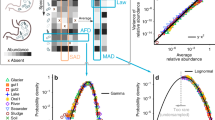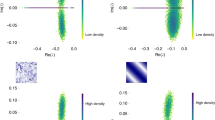Abstract
Trade-offs among the abilities of organisms to respond to different environmental factors are often assumed to play a major role in the coexistence of species. There has been extensive theoretical study of the role of such trade-offs in ecological communities but it has proven difficult to study such trade-offs experimentally. Microorganisms are ideal model systems with which to experimentally study the causes and consequences of ecological trade-offs. In model communities of E. coli B and T-type bacteriophage, a trade-off in E. coli between resistance to bacteriophage and competitive ability is often observed. This trade-off can allow the coexistence of different ecological types of E. coli. The magnitude of this trade-off affects, in predictable ways, the structure, dynamics and response to environmental change of these communities. Genetic factors, environmental factors, and gene-by-environment interactions determine the magnitude of this trade-off. Environmental control of the magnitude of trade-offs represents one avenue by which environmental change can alter community properties such as invasability, stability and coexistence.
Similar content being viewed by others
References
Antonovics K & Ellstrand NC (1983) Experimental studies of the evolutionary significance of sexual reproduction. I. A test of the frequency-dependent selection hypothesis. Evolution 38: 103–115.
Bergelson J (1994) The effects of genotype and the environment on costs of resistance in lettuce. Am. Natur. 143: 349–359.
Bergelson J, Purrington CB, Palm CJ & LopezGutierrez JC (1996) Costs of resistance: A test using transgenic Arabidopsis thaliana. Proc. R. Soc. Lond. Series B. Biolog. Sci. 263: 1659–1663.
Bohannan BJM & Lenski RE (1997) The effect of resource enrichment on a chemostat community of bacteria and phage. Ecology 78: 2303–2315.
Bohannan BJM & Lenski RE (1999) Effect of prey heterogeneity on the response of a model food chain to resource enrichment. Am. Natur. 153: 73–82.
Bohannan BJM & Lenski RE (2000a) The relative importance of competition and predation varies with productivity in a model community. Am. Natur. 156: 329–340.
Bohannan BJM & Lenski RE (2000b) Linking genetic change to community evolution: insights from studies of bacteria and bacteriophage. Ecol. Lett. 3: 362–377.
Bohannan BJM, Travisano M & Lenski RE (1999) Epistatic interactions can lower the cost of resistance to multiple consumers. Evolution 53: 292–295.
Boots M & Haraguchi Y (1999) The evolution of costly resistance in host-parasite systems. Am. Natur. 153: 359–370.
Carlton BC & Brown BJ (1981) Gene mutation. In: Gerhardt P (Ed) Manual ofMethods for General Bacteriology (pp 222–242). American Society for Microbiology, Washington, D.C.
Chao L & Levin BR (1981) Structured habitats and the evolution of anticompetitor toxins in bacteria. Proc. Nat. Acad. Sci. 78: 6324–6328.
Dieckmann U & Doebeli M (1999) On the origin of species by sympatric speciation. Nature 400: 354–357.
Dieckmann U, Law R & Metz JAJ (Eds) (2000) The Geometry of Ecological Interactions. Cambridge University Press, Cambridge, UK.
Durrett R & Levin S (1997) Allelopathy in spatially distributed populations. J. Theor. Biol. 185: 165–171.
Dykhuizen DE (1998) Santa Rosalia revisited: Why are there so many species of bacteria? Antonie van Leeuwenhoek 73: 25–33.
Feldgarden M & Riley MA (1999) The phenotypic and fitness effects of colicin resistance in Escherichia coli K-12. Evolution 53: 516–525.
Fuhrman JA (1999) Marine viruses and their biogeochemical and ecological effects. Nature 399: 541–548.
Goldberg E, Grinius L & Letellier L (1994) Recognition, attachment and injection In: Mathews K (Ed) Molecular Biology of Bacteriophage T4, (pp 347–356). American Society for Microbiology, Washington, D.C.
Grover JP (1997) Resource Competition. Chapman and Hall, London.
Hantula J, Kurki A, Vuoriranta P & Bamford DH (1991) Ecology of bacteriophage infecting activated sludge bacteria. Appl. Environ. Microbiol. 57: 2147–2151.
Holt RD (1977) Predation, apparent competition, and the structure of prey communities. Theoret. Popul. Biol. 11: 197–229.
Huisman J & Wessing FJ (2001) Biological conditions for oscillations and chaos generated by multispecies competition. Ecology 82: 2682–2695.
Huisman J, Johansson AM, Folmer EO & Weissing FJ (2001) Towards a solution of the plankton paradox: the importance of physiology and life history. Ecol. Lett. 4: 408–411.
Iwasa Y, Nakamaru M & Levin SA (1998) Allelopathy of bacteria in a lattice population: Competition between colicin-sensitive and colicin-producing strains. Evolut. Ecol. 12: 785–802.
Kerr B, Riley MA, Feldman MW & Bohannan BJM (2002) Local dispersal promotes biodiversity in a real-life game of rock-paperscissors. Nature 418: 171–174.
Kraaijeveld AR & Godfray HCJ (1997) Trade-off between parasitoid resistance and larval competitive ability in Drosophila melanogaster. Nature 389: 278–280.
Leibold MA (1996) A graphical model of keystone predators in food webs: trophic regulation of abundance, incidence and diversity patterns in communities. Am. Natur. 147: 784–812.
Lenski RE (1984) Two-step resistance by Escherichia coli B to bacteriophage T2. Genetics 107: 1–7.
Lenski RE (1988a) Experimental studies of pleiotropy and epistasis in Escherichia coli. I. Variation in competitive fitness among mutants resistant to virus T4. Evolution 42: 425–432.
Lenski RE (1988b) Experimental studies of pleiotropy and epistasis in Escherichia coli. II. Compensation for maladaptive effects associated with resistance to virus T4. Evolution 42: 433–440.
Lenski RE (1988c) Dynamics of interactions between bacteria and virulent bacteriophage. Adv. Microbial. Ecol. 10: 1–44.
Lenski RE & Levin BR (1985) Constraints on the coevolution of bacteria and virulent phage: a model, some experiments, and predictions for natural communities. Am. Natur. 125: 585–602.
Lenski RE, Rose MR, Simpson SC & Tadler SC (1991) Long-term experimental evolution in Escherichia coli. I. Adaptation and divergence during 2,000 generations. Am. Natur. 138: 1315–1341.
Levin BR, Perrot V & Walker N (2000) Compensatory mutations, antibiotic resistance and the population genetics of adaptive evolution in bacteria. Genetics 154: 985–997.
Levin BR, Stewart FM & Chao L (1977) Resource-limited growth, competition, and predation: a model and experimental studies with bacteria and bacteriophage. Am. Natur. 111: 3–24.
Lubchenco J (1978) Plant species diversity in a marine intertidal community: importance of herbivore food preference and algal competitive abilities. Am. Natur. 112: 23–39.
Mitra R & Bhatia CR (1982) Bioenergetic considerations in breeding for insect and pathogen resistance in plants. Euphytica 31: 429–437.
Paine RT (1966) Food web complexity and species diversity. Am. Natur. 100: 65–75.
Simms EL (1992) Costs of plant resistance to herbivory. In: Fritz RS & Simms EL (Eds) Plant Resistance to Herbivores and Pathogens (pp 392–425). University of Chicago Press, Chicago.
Tan JSH & Reanney DC (1976) Interactions between bacteriophages and bacteria in soil. Soil Biol. Biochem. 8: 145.
Thompsol JN (1989) Concepts of coevolution. TREE 4: 179–183.
Tilman D (2000) Causes, consequences and ethics of biodiversity. Nature 405: 208–211.
Tilman D & Kareiva P (Eds) (1997). Spatial Ecology. Princeton University Press, Princeton.
Travisano M & Rainey P (2000) Studies of adaptive radiation using model microbial systems. Am. Natur. 156: S35–S44.
Waterbury JB & Valois FW (1993) Resistance to co-occurring phages enables marine Synechococcus communities to coexist with cyanophages abundant in seawater. Appl. Environ. Microbiol. 59: 3393–3399.
Whitman WB, Coleman DC & Wiebe WJ (1998) Prokaryotes: The unseen majority. Proc. Nat. Acad. Sci. 95: 6578–6581.
Wommack KE & Colwell RR (2000) Virioplankton: viruses in aquatic ecosystems. Microbiol. Molec. Biol. Rev. 64: 69–114.
Author information
Authors and Affiliations
Corresponding author
Rights and permissions
About this article
Cite this article
Bohannan, B.J., Kerr, B., Jessup, C.M. et al. Trade-offs and coexistence in microbial microcosms. Antonie Van Leeuwenhoek 81, 107–115 (2002). https://doi.org/10.1023/A:1020585711378
Issue Date:
DOI: https://doi.org/10.1023/A:1020585711378




